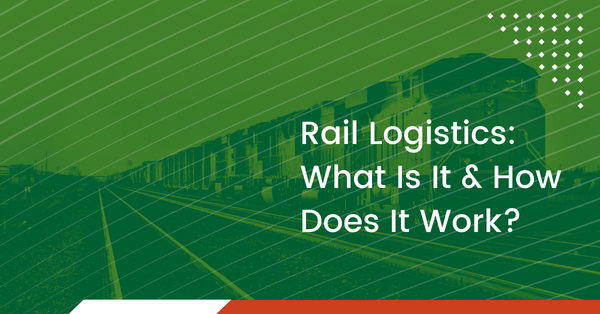Shippers are always looking for the most efficient and cost-effective way to transport freight. Companies with a healthy supply chain traditionally utilize more than one mode of transportation for this reason.
Rail is one of the most cost-effective and eco-friendly ways to transport your freight.
What Is Rail Logistics
When companies are looking to ship large amounts of freight, usually more than 120,000 pounds, to the same place simultaneously, rail shipping can sometimes provide the best option.
Railcar shipping is often cheaper and more eco-friendly than shipping via truck.
Railcar types
The rail industry can accommodate countless products thanks to their many rail car options
Box car
Boxcars can carry a variety of freight, anything from paper, lumber, packaged goods, beverages, and other palletized freight. There are a few size variations with boxcars, 50 ft plain, 60 ft plain, and insulated. The insulated length can range from 57 to 71 ft.
CenterBeam
CenterBeam cars are best for bundled goods such as lumber, wallboard, fence posts, and other building materials. A standard CenterBeam rail car is 73 ft long with a carrying capacity between 194,000 and 225,900 pounds.
Coil Cars
Coil cars are designed for steel and other similar products. Load limits for these cars are around 226,000 pounds.
Flat Cars
Flat cars are great for pipe, rail, steel plate, machinery, steel beams, tractors, military vehicles, lumber, poles, logs, and other oversized and oddly shaped freight. These cars are traditionally 60 – 90 ft long with a load limit between 142,000 and 210,000 pounds.
Gondola
Used primarily for heavy bulk materials like scrap metal, logs, lumber, steel, sand, and iron ore, these cars range from 52 – 65 ft long and have a load limit between 158,000 to 267,000 pounds.
Covered/Closed Hoppers
These covered cars are fantastic for cement, rooking granules, sand, corn, wheat, barley, fertilizer, sugar, and rice. Different kinds of covered/ closed hoppers are designed for your specific needs. For example, if you are shipping cement, roofing granules, or sand, cars are available with a load limit of up to 233,000 pounds. There are also food-grade hoppers for food freight.
Open Top Hoppers
These open hoppers are best for shipping coal, petroleum coke, sand, rock, and other products that can be exposed to the elements.
Tank Cars
Fairly straightforward, tank cars move chemicals, molasses, fuel, and other liquid or gas products. These cars, however, are privately owned and can be hard to get. They can hold between 6,500 and 31,000 gallons of material.
Advantages Of Rail Freight Logistics
Along with its cost savings potential, rail is optimal for pre-planned long-hauls, and moving from over the road to rail could benefit your supply chain in several ways. For example, using rail can elevate concerns with capacity, gas emissions, and driver shortages.
Additionally, according to the Association of American Railroads, more investments in rail infrastructure are increasing rail transportation’s safety and efficiency, resulting in a higher safety level thanks to less human involvement and the absence of highway congestion.
New technology innovations in rail are also a great advantage. Automation, modern railway systems, big data, IoT, and artificial intelligence are new tools impacting rail transportation.
Railroad vs. Trucking
Cost
Think for a moment about a large freight shipment of over 150,000 pounds. Moving that load using trucks would take multiple trucks and drivers, costing you a large amount in fuel costs.
Rail would not require that type of fuel investment. While trucks deliver freight faster than trains, it could cost thousands more.
Environmental
A highly impactful advantage of rail transport over trucking is being less harmful to the environment. Generally, railcar shipments cause fewer carbon emissions into the atmosphere per ton-mile.
Considerations for Rail
If your company is thinking of using rail to benefit your supply chain, there are a couple of things to consider:
- Does the customer have rail access at the origin and destination?
- The freight has to be shipped and delivered. As simple as it sounds, you must ensure the freight can get where it needs to go.
- Rail rates can take up to a month to get
- Plan as best you can. The sooner you have a plan to move your freight, the better.
- Rates do not exist for all routes.
- Rail cannot always access locations where you ship.
- Rates are based on origin and destination, commodity, and rail car.
- As with everything in your supply chain, what you are shipping and where it will ultimately dictate your price.
- Transload equipment needed to load railcar
- Consider the equipment needed to load and unload your product. In some cases, products must be unloaded from a railcar and loaded onto a truck. Make sure you have what you need secured to make that happen.
Consider Demurrage
Across all industries, importers, and exporters face a problem: demurrage fees.
Demurrage is a fee a carrier, port, or railroad companies charge for storing containers or rail cars that exceed the free time offered for loading and unloading. Once the free time is expired, the shipper gets charged a daily demurrage fee until the cargo leaves the terminal.
The available time for demurrage to kick depends on the location. Shipments that arrive via plane or train have 48 hours of free storage time, whereas port times typically range from four to seven days. All ports of entry have differing policies, so you should research the port’s policy before shipping. Charges differ based on the terminal or carrier and can range from $75 to $150 per container, per day, during the first five days, with additional fees added the longer the container stays.


